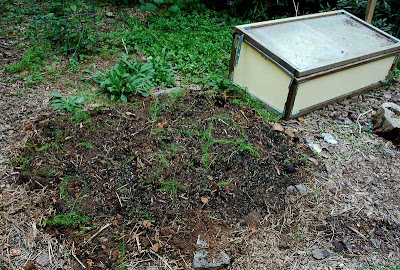Fall vegetable gardening
It was a good day in the garden. Feeling much better today after a nasty bout with H1N1 last week, my gardening companion and I puttered happily doing (relatively) small garden projects. Tiring, of course, and it required a bit of rest on both of our parts, but it was delightful to be outside.
 I cleaned up the rest of the satellite (vegetable) garden, and transplanted some asparagus seedlings that I'd grown from seed (a European variety called Precoce d' Argenteuil) which I'd purchased in an enthusiastic buying session last winter. They clearly must have been described in a evocative way. They were nice hefty young seedlings and I tucked them into a bed rich with organic matter.
I cleaned up the rest of the satellite (vegetable) garden, and transplanted some asparagus seedlings that I'd grown from seed (a European variety called Precoce d' Argenteuil) which I'd purchased in an enthusiastic buying session last winter. They clearly must have been described in a evocative way. They were nice hefty young seedlings and I tucked them into a bed rich with organic matter.
I covered other beds with nicely decomposed straw, thanks to my hay bale experiment last spring. I didn't actually end up with crops from the hay bales (uh, woodchucks can climb, I guess), but the compost planting holes stimulated decomposition much more rapidly than usual. One of the double bales is still in good shape, so I'm going to leave it for a spring planting experiment. We'll see.
 My plan is to plant garlic and shallots in some of the satellite garden beds this fall, but let the others get ready for spring greens. Other garlic cloves will be planted in the main vegetable garden, which I'm planning to cover in spring with a crab/shrimp shell fertilizer product that will encourage chitin-consuming micro-organisms. (The idea is that they will also yum up the root-knot nematode larvae, which have chitin in their composition). Hmm.
My plan is to plant garlic and shallots in some of the satellite garden beds this fall, but let the others get ready for spring greens. Other garlic cloves will be planted in the main vegetable garden, which I'm planning to cover in spring with a crab/shrimp shell fertilizer product that will encourage chitin-consuming micro-organisms. (The idea is that they will also yum up the root-knot nematode larvae, which have chitin in their composition). Hmm.
But letting the main vegetable garden beds be largely fallow over the summer growing season next year may be the most effective 'rotation' to decrease the populations of nematodes.
 I cleaned up the rest of the satellite (vegetable) garden, and transplanted some asparagus seedlings that I'd grown from seed (a European variety called Precoce d' Argenteuil) which I'd purchased in an enthusiastic buying session last winter. They clearly must have been described in a evocative way. They were nice hefty young seedlings and I tucked them into a bed rich with organic matter.
I cleaned up the rest of the satellite (vegetable) garden, and transplanted some asparagus seedlings that I'd grown from seed (a European variety called Precoce d' Argenteuil) which I'd purchased in an enthusiastic buying session last winter. They clearly must have been described in a evocative way. They were nice hefty young seedlings and I tucked them into a bed rich with organic matter.I covered other beds with nicely decomposed straw, thanks to my hay bale experiment last spring. I didn't actually end up with crops from the hay bales (uh, woodchucks can climb, I guess), but the compost planting holes stimulated decomposition much more rapidly than usual. One of the double bales is still in good shape, so I'm going to leave it for a spring planting experiment. We'll see.
 My plan is to plant garlic and shallots in some of the satellite garden beds this fall, but let the others get ready for spring greens. Other garlic cloves will be planted in the main vegetable garden, which I'm planning to cover in spring with a crab/shrimp shell fertilizer product that will encourage chitin-consuming micro-organisms. (The idea is that they will also yum up the root-knot nematode larvae, which have chitin in their composition). Hmm.
My plan is to plant garlic and shallots in some of the satellite garden beds this fall, but let the others get ready for spring greens. Other garlic cloves will be planted in the main vegetable garden, which I'm planning to cover in spring with a crab/shrimp shell fertilizer product that will encourage chitin-consuming micro-organisms. (The idea is that they will also yum up the root-knot nematode larvae, which have chitin in their composition). Hmm.But letting the main vegetable garden beds be largely fallow over the summer growing season next year may be the most effective 'rotation' to decrease the populations of nematodes.
Your readers with late season herb and vegetable gardens may well find that they will grow more than they can use, preserve or give to friends.
ReplyDeleteThey may want to visit www.AmpleHarvest.org - a site that helps diminish hunger by enabling backyard gardeners to share their crops with neighborhood food pantries.
The site is free both for the food pantries and the gardeners using it.
More than 970 food pantries nationwide are already on it and more are signing up daily.
It includes preferred delivery times, driving instructions to the pantry as well as (in many cases) information about store bought items also needed by the pantry (for after the growing season).
AmpleHarvest.org enables people to help their community by reaching into their back yard instead of their back pocket.
Lastly, if your reader's community has a food pantry, they should make sure the pantry registers on www.AmpleHarvest.org. Its free.
Where do you purchase the shrimp/crab shell meal for the root knot nematodes? I need to purchase some as well. I am in Florida. You would think it would be abundant down here but I am having a hard time finding it.
ReplyDelete